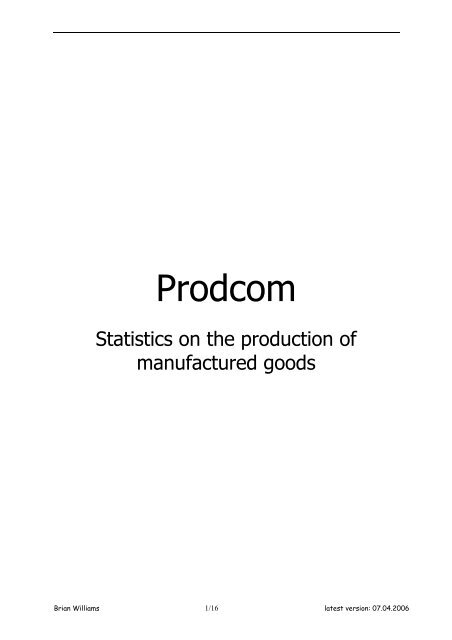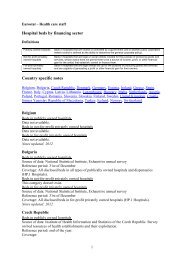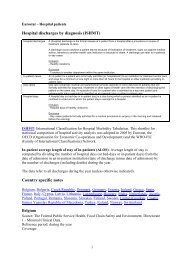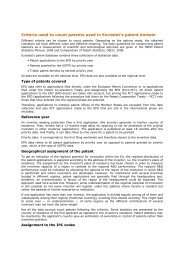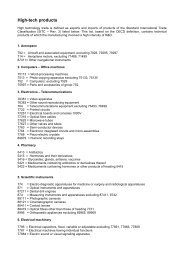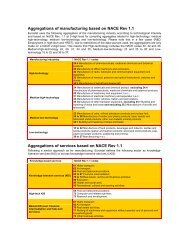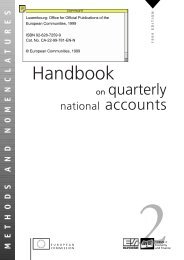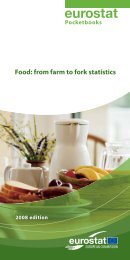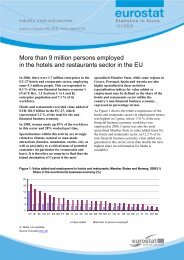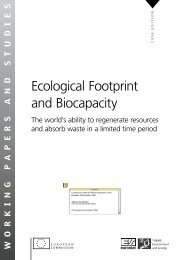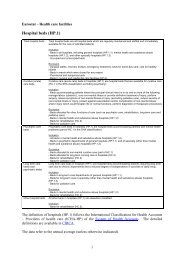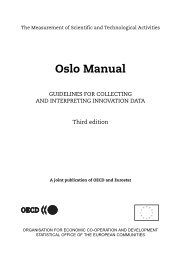PRODCOM DATA - Eurostat
PRODCOM DATA - Eurostat
PRODCOM DATA - Eurostat
Create successful ePaper yourself
Turn your PDF publications into a flip-book with our unique Google optimized e-Paper software.
Prodcom<br />
Statistics on the production of<br />
manufactured goods<br />
Brian Williams 1/16 latest version: 07.04.2006
Table of contents<br />
1. Summary of the <strong>PRODCOM</strong> regulation.......................................................... 3<br />
1.1 Introduction............................................................................................................................. 3<br />
1.2 What data are to be collected?............................................................................................... 3<br />
1.3 Which countries report <strong>PRODCOM</strong> data?.......................................................................... 3<br />
1.4 When are data to be collected................................................................................................ 4<br />
1.5 How are data to be collected? ................................................................................................ 4<br />
1.6 Transmission of results........................................................................................................... 4<br />
1.7 Estimations .............................................................................................................................. 4<br />
2. Description of <strong>PRODCOM</strong>............................................................................... 5<br />
2.1 Background to <strong>PRODCOM</strong>................................................................................................... 5<br />
2.2 The <strong>PRODCOM</strong> List .............................................................................................................. 6<br />
3. Publication of <strong>PRODCOM</strong> data....................................................................... 8<br />
3.1 Europroms: General introduction......................................................................................... 8<br />
3.2 Data on production: Prodcom ............................................................................................... 8<br />
3.2.1 Prodcom covers manufactured goods in NACE divisions 13 to 36................................................ 8<br />
3.2.2 Available variables.......................................................................................................................... 8<br />
3.2.3 Periodicity ....................................................................................................................................... 8<br />
3.2.4 Availability of data.......................................................................................................................... 8<br />
3.3. Data on foreign trade.................................................................................................................. 9<br />
3.3.1 Data available on external trade in Europroms ............................................................................... 9<br />
3.3.2 How production and foreign trade data are matched. ..................................................................... 9<br />
3.4 Differences between Prodcom and Foreign trade data ..................................................... 10<br />
3.4.1 Some remarks concerning comparisons between Prodcom and foreign trade .............................. 10<br />
3.6 How to access the data in Europroms:................................................................................ 11<br />
3.7 Rounding of EU totals:......................................................................................................... 12<br />
4. Some hints about <strong>PRODCOM</strong> data............................................................... 14<br />
4.1 Purpose of <strong>PRODCOM</strong> ........................................................................................................ 14<br />
4.2 What is <strong>PRODCOM</strong>? ........................................................................................................... 14<br />
4.3 The <strong>PRODCOM</strong> codes ......................................................................................................... 15<br />
4.4 <strong>PRODCOM</strong> information...................................................................................................... 15<br />
4.5 The difference between <strong>PRODCOM</strong> and Europroms....................................................... 16<br />
4.6 Confidentiality in <strong>PRODCOM</strong> ............................................................................................ 16<br />
Brian Williams 2/16 latest version: 07.04.2006
1. Summary of the <strong>PRODCOM</strong> regulation<br />
1.1 Introduction<br />
<strong>PRODCOM</strong> data are detailed production data on an 8 digit level. Only information on<br />
this level can be found in the <strong>PRODCOM</strong> data<br />
The <strong>PRODCOM</strong> regulation is to be found in the Official Journal No L374/1, which stipulates<br />
that “the production surveyed shall be only that production actually carried out on its<br />
territory”.<br />
1.2 What data are to be collected?<br />
Normally the following information is requested for each heading:<br />
• the physical volume of production sold during the survey period<br />
• the value of production sold during the survey period<br />
In certain circumstances reporting countries must also record the physical volume of actual<br />
production during the survey period, including what is used by the enterprise in any other<br />
production.<br />
In undertaking the <strong>PRODCOM</strong> survey, there are three conditions to be met:<br />
• in each Member State at least 90% of production in each (four digit) class of NACE<br />
Rev. 1 must be recorded<br />
• any enterprise of 20 or more employees should be taken into account<br />
• if a Member State’s production in each NACE class represents less than 1% of the<br />
Community total, then data for the headings in that class does not need to be<br />
collected. In this case production should be reported as zero<br />
1.3 Which countries report <strong>PRODCOM</strong> data?<br />
In addition to the Member States, the EEA-EFTA countries Norway and Iceland are bound by<br />
the <strong>PRODCOM</strong> regulation. They conduct <strong>PRODCOM</strong> surveys and transmit the data to<br />
<strong>Eurostat</strong>. Bulgaria, Croatia and Romania also report <strong>PRODCOM</strong> data. National data for all<br />
non-Member State countries are published individually but not included in EU totals.<br />
Brian Williams 3/16 latest version: 07.04.2006
1.4 When are data to be collected<br />
The <strong>PRODCOM</strong> survey is:<br />
• an annual survey<br />
• the Member States can choose to run their survey monthly, quarterly or annually as<br />
long as the data are supplied to <strong>Eurostat</strong> as annual data<br />
• data from 1995 onwards are published.<br />
1.5 How are data to be collected?<br />
• Member States use a survey questionnaire which conforms to the requirements of the<br />
regulation. They may also use other sources of information to supplement the survey.<br />
• enterprises are asked to give true and complete information within the stipulated<br />
deadlines<br />
1.6 Transmission of results<br />
After data have been collected, the Member States send them to <strong>Eurostat</strong>:<br />
• within 6 months of the end of the reference year for annual data<br />
• data which under national law are confidential are also transmitted to <strong>Eurostat</strong>, and<br />
handled under the rules of the Statistical Law<br />
1.7 Estimations<br />
For some headings reporting countries are unable to supply the data, normally because of<br />
non-response of the enterprises they have surveyed. If data for one or more countries is<br />
missing, <strong>Eurostat</strong> is unable to calculate EU totals for that heading. In order to avoid this<br />
situation, <strong>Eurostat</strong> makes estimates for missing data. These are not included in the published<br />
national data, but are used in aggregating individual country data to obtain EU totals. Any EU<br />
totals that contain one or more estimates are marked as estimated (:E).<br />
Brian Williams 4/16 latest version: 07.04.2006
2. Description of <strong>PRODCOM</strong><br />
2.1 Background to <strong>PRODCOM</strong><br />
<strong>PRODCOM</strong> is the title of the EU production statistics for mining and quarrying,<br />
manufacturing, and electricity, gas and water supply, that is sections C, D, and E of the<br />
Statistical Classification of Economic Activity in the European Union (NACE Rev. 1), though<br />
some areas are not currently covered. The title comes from the French “PRODuction<br />
COMmunautaire” (Community Production).<br />
The basis of the survey is Council Regulation (EEC) No 3924/91 on the establishment of a<br />
Community survey of industrial production (<strong>PRODCOM</strong> Regulation), which states that<br />
production is to be recorded according to the product headings of the <strong>PRODCOM</strong> list. A<br />
Commission Regulation implementing the <strong>PRODCOM</strong> Council Regulation was adopted in<br />
April 2004.<br />
The evolution of <strong>PRODCOM</strong> dates back to 1985 when there were the first meetings of the<br />
working party on "Production Statistics", whose objective was to harmonise the various ways<br />
industrial production statistics were collected in the Member States.<br />
Although in most countries statistics were collected on production, these covered the national<br />
situation, and national nomenclatures were used and different survey methods applied.<br />
The basis of <strong>PRODCOM</strong> is to enable these national statistics to be compared and where<br />
possible aggregated to give a picture of the developments of an industry or product in the<br />
European context. This aim became more urgent with the creation of the single market in<br />
1992, and with rapid changes occurring in Europe, the statistical system had to adapt to<br />
these changes.<br />
Brian Williams 5/16 latest version: 07.04.2006
2.2 The <strong>PRODCOM</strong> List<br />
Before data collection could begin, it was necessary to draw up a common list of products to<br />
be covered. Drawing up the <strong>PRODCOM</strong> list was a unique opportunity for <strong>Eurostat</strong>, the NSIs<br />
and the European Trade Associations (FEBIs) to work together to produce a classification<br />
that would work on the micro, national and European level. The two principal aims were to<br />
measure production and to enable a calculation of apparent consumption by linking<br />
production statistics to foreign trade statistics.<br />
As <strong>PRODCOM</strong> statistics have to be comparable with external trade statistics, which are<br />
based on the Combined Nomenclature (CN) there had to be a close relationship between the<br />
two nomenclatures. Furthermore, the basic building blocks for <strong>PRODCOM</strong> are NACE Rev. 1<br />
and the Classification of products by activity (CPA ), therefore the <strong>PRODCOM</strong> list had to be<br />
developed in close association with these nomenclatures.<br />
To understand how the different nomenclatures fit together, and their links to world-wide<br />
nomenclatures it is useful to consider the diagram below which gives an overview of the<br />
revised system of integrated statistical classifications. This diagram shows the clear links<br />
between the <strong>PRODCOM</strong> list and the CN, which then links up to the HS at a world-wide level.<br />
<strong>PRODCOM</strong> headings are directly derived from the 2 nomenclatures to their left on the<br />
diagram –NACE Rev. 1 and the CPA. The 8-digit <strong>PRODCOM</strong> code takes its first 4 digits from<br />
NACE and digits 5 and 6 from the CPA, thus enabling a consistent link to these two<br />
classifications.<br />
However, it was felt by the <strong>PRODCOM</strong> committee that there were instances where the CN<br />
classification gave too much detail in how it broke down products within a specific category,<br />
but equally instances when it did not give enough detail to meet the needs of the likely end<br />
users of <strong>PRODCOM</strong> data such as the European federations and other professional<br />
associations.<br />
As a result of these discussions it was decided to base the <strong>PRODCOM</strong> list on the CN but<br />
with some modifications. The result was a list of 5765 headings which was published in<br />
Brian Williams 6/16 latest version: 07.04.2006
November 1993 in all nine official languages of the Union. It has since been extended to 20<br />
Community languages (all except Maltese) plus Norwegian. Each year some changes are<br />
made to the list to improve it. These can range from a new break-down of the codes used for<br />
products, an improvement to the translation of a heading for a languages or a restructuring of<br />
some headings as a result of changes in an industry.<br />
Over the years the List has been added to in various ways to satisfy the demands of various<br />
users. The List has become increasingly complex, and little attention was paid to the<br />
feasibility of collecting data on all the required headings.<br />
In order to improve the quality of <strong>PRODCOM</strong> statistics and reduce the burden on Member<br />
States, a number of changes were made to the <strong>PRODCOM</strong> List for 2005. The major changes<br />
were as follows:<br />
- Remove the detailed optional headings from the <strong>PRODCOM</strong> List (560 B<br />
headings). The fact that they were optional means that they were never fully<br />
reported.<br />
- Remove the concept of production intended for sale (62 type C headings) and use<br />
sold production (S) instead. Data on production intended for sale was poorly<br />
reported.<br />
- Remove quarterly data (1079 headings). These concerned textiles, but four<br />
countries never supplied quarterly data so was never possible to produce EU<br />
totals. The substantial resources required in those countries that did conduct a<br />
quarterly survey could not therefore be justified.<br />
- Remove z-headings and keep the Z-headings (174 z-headings). Z-headings are<br />
aggregates of the z-headings that enable a link to be made to Combined<br />
Nomenclature headings. Often data for either the aggregates or the detailed<br />
headings was missing, and even where detailed data was supplied, aggregates<br />
cold not always be calculated because of confidentiality issues.<br />
- Remove N-headings (228 headings). These were intended to provide a<br />
breakdown of products according to the class of origin, but were poorly reported.<br />
- Remove the second volume unit for all headings. For some products, the List<br />
required volume data to be expressed in two units, but this requirement was<br />
seldom respected and EU totals for the second unit were never possible.<br />
- Remove other headings that were poorly reported. In application of this principle,<br />
energy headings were removed from the List.<br />
In 2006, monthly reporting of steel statistics was also removed.<br />
Brian Williams 7/16 latest version: 07.04.2006
3. Publication of <strong>PRODCOM</strong> data<br />
3.1 Europroms: General introduction<br />
Europroms is the name given to published <strong>PRODCOM</strong> data. It differs from <strong>PRODCOM</strong> in<br />
that it combines Production data from <strong>PRODCOM</strong> with Import and Export data from the<br />
Foreign Trade database.<br />
Europroms is published in the Comext database in the tables <strong>PRODCOM</strong> ANNUAL (1995<br />
onwards) and <strong>PRODCOM</strong> MONTHLY STEEL (2003 to 2005 only). The data from these<br />
tables are included in a monthly DVD entitled "Intra- and extra- EU trade" The <strong>PRODCOM</strong><br />
data on the DVD contains the same data as the on-line database and uses the same<br />
interface to access the data.<br />
Each month the updated tables are transferred to the <strong>Eurostat</strong> website.<br />
3.2 Data on production: Prodcom<br />
3.2.1 Prodcom covers manufactured goods in NACE divisions 13 to 36<br />
3.2.2 Available variables<br />
<strong>PRODCOM</strong> headings are classified according to one of the following production types:<br />
Sold production: the products manufactured by the enterprise and sold outside the<br />
enterprise during the reference period. The value and volume of production of the product<br />
should be reported.<br />
Total production: the products manufactured during the reference period including those<br />
sold outside the enterprise and those retained for reuse by the enterprise as input to the<br />
manufacture of other products. In addition the volume of total production and the value and<br />
volume of sold production must be reported (2005 onwards).<br />
The preferred variable is production sold, in value and in quantity, because this corresponds<br />
most closely to the part of the production that is put on the market.<br />
Total production in quantity can convey interesting information in particular in the case of<br />
integrated production (when a company produces certain products and then uses them to<br />
produce other products).<br />
3.2.3 Periodicity<br />
The main set of <strong>PRODCOM</strong> data is production reported on an annual basis.<br />
In addition production by volume of 88 steel products was reported monthly from January<br />
2003 to December 2005.<br />
3.2.4 Availability of data<br />
There are two reasons why expected data might not be found in Europroms:<br />
- The data is confidential. If only a small number of enterprises produce a product in<br />
the reporting country, there is a risk that information regarding an individual enterprise<br />
might be revealed. If the enterprise does not agree to this the reporting country<br />
Brian Williams 8/16 latest version: 07.04.2006
declares the production figures confidential. They are transmitted to <strong>Eurostat</strong> but not<br />
published.<br />
However if several countries declare their production for a heading to be confidential,<br />
an EU total can be published because the data for an individual country cannot be<br />
inferred.<br />
- The data is estimated, because no figures were supplied by the reporting country.<br />
There are a number of reasons why data might be missing: the reporting country<br />
does not survey the heading; the reporting country has reason to doubt the accuracy<br />
of the data and suppresses it; or the reporting country uses the wrong volume unit or<br />
the wrong production type, which means that the data is not comparable with other<br />
countries and is suppressed by <strong>Eurostat</strong>. <strong>Eurostat</strong> makes estimates for missing data,<br />
but only uses them in EU totals. In the national data estimates are suppressed and<br />
marked with :E.<br />
If data is missing for one or more Member States the corresponding EU total cannot be<br />
calculated and is also marked as missing. In these cases <strong>Eurostat</strong> makes estimates for the<br />
missing data (see paragraph 1.7)<br />
-<br />
3.3. Data on foreign trade<br />
3.3.1 Data available on external trade in Europroms<br />
Europroms is not designed as a tool to distribute the external trade statistics of the Member<br />
States of the EU. Complete and detailed statistics for foreign trade are available in Comext,<br />
and the data used in Europroms are extracted from this base.<br />
Europroms contains only the data on foreign trade corresponding to production data and<br />
necessary for the calculation of markets.<br />
Due to confidentiality a small part of foreign trade information is not available at the most<br />
detailed level (CN code, partner country, value or quantity); this means in practice that at this<br />
detailed level the information may not be complete. The complete information is only<br />
available on a more aggregated level in the Comext database.<br />
Prodcom headings which refer to industrial services are not reflected by a CN code either.<br />
3.3.2 How production and foreign trade data are matched.<br />
There are several aspects to the matching of production and foreign trade data in<br />
Europroms:<br />
The products:<br />
In most cases the <strong>PRODCOM</strong> code corresponds to one or more CN codes, so the data for<br />
all corresponding CN headings is aggregated to get the import and export figures for the<br />
<strong>PRODCOM</strong> code.<br />
If the <strong>PRODCOM</strong> product does not have an equivalent product in the trade figures (for<br />
instance industrial services) no trade data is displayed alongside the production data.<br />
Similarly, if the <strong>PRODCOM</strong> product is a breakdown of a CN code, it is not possible to<br />
compare it with external trade and no trade data is displayed.<br />
The reporting countries:<br />
Normally there is a simple match between Foreign Trade and <strong>PRODCOM</strong> countries.<br />
However up to 1998 Belgium and Luxembourg made a joint Foreign Trade declaration,<br />
whereas in <strong>PRODCOM</strong> their data was reported separately from the beginning. As it is not<br />
Brian Williams 9/16 latest version: 07.04.2006
possible to distinguish trade from the two countries up to that time, it is all attributed to<br />
Belgium when trade data is shown alongside production data.<br />
For EU totals the trade for all EU Member States is aggregated.<br />
The volume unit:<br />
Foreign Trade is reported by weight and for some products also by another unit (the<br />
supplementary unit). Production data is reported by a unit that is kg for some products and a<br />
different unit for other products.<br />
-<br />
- If the production data has another unit and it is the same as the foreign trade<br />
supplementary unit, the trade data from the supplementary unit is displayed.<br />
- If the production data has a unit that is neither kg nor the same as the foreign trade<br />
supplementary unit, the trade data is not displayed.<br />
The foreign trade partner countries:<br />
When comparing production with trade figures we want to consider all the trade passing the<br />
external borders of the territory in question. For individual Member States this means all<br />
external trade, i.e. the sum of the trade with all Intra-EU and all Extra-EU partners. However<br />
for EU totals we are only interested in trade leaving and entering the EU as a whole, so the<br />
sum of trade with all Extra-EU partners is displayed.<br />
Production type:<br />
The only production type which can be usefully compared with trade data is Sold Production.<br />
Therefore Europroms only displays trade data where the production type is Sold Production.<br />
3.4 Differences between Prodcom and Foreign trade data<br />
3.4.1 Some remarks concerning comparisons between Prodcom and foreign trade<br />
(i) Some Prodcom headings cover a range of products, which means that the composition<br />
of production can in some cases differ from that of trade. Obviously, such<br />
heterogeneity complicates the integration of production and trade data.<br />
(ii) The coverage of production statistics is not necessarily in line with that of trade<br />
statistics. The thresholds above which businesses are represented in these statistics<br />
can be different.<br />
(iii) The data presented here relate to a given year and there are temporal delays between<br />
the various operations taken into account: production, sale, export. Storage explains a<br />
part of these delays which are reduced or even disappear when the data are<br />
considered over several years.<br />
(iv) Where external trade nomenclatures permit, the trade in used and second-hand goods<br />
is excluded from the calculation of markets figures. However, in some cases, used<br />
goods cannot be distinguished from new ones. In particular the export of used<br />
machines (often somewhat renovated) to Third World countries can skew the apparent<br />
market.<br />
(v) The Combined Nomenclature has in many areas separate subheadings related to civil<br />
aircraft. Classification of goods (which is subject to conditions laid down in Community<br />
provisions) is only relevant in relation to the rate of duty. In a number of cases the<br />
import and export under these subheadings is not taken into account for the calculation<br />
Brian Williams 10/16 latest version: 07.04.2006
of market data, because they lack the level of detail to be assigned to a single<br />
Prodcom heading.<br />
(vi) The value of exports cannot always be compared directly with that of sold production.<br />
The latter is based on the ex-work selling price, whereas exports are evaluated at the<br />
time the goods cross the border. In addition, imported goods can be exported again<br />
with a different value, either without being modified or after industrial processing (e.g.<br />
textile finishing or surface treatment) which is not linked to external trade in Europroms.<br />
(vii) A Commission Regulation ((EEC) No 518/79) allows a simplified declaration procedure<br />
for the export of complete industrial plants. On the basis of this Regulation part of the<br />
complete industrial plant is classified in Chapter 98 of the CN, which is not taken into<br />
account in the market calculation.<br />
(viii) The production of subcontracting cannot be linked directly to external trade. Products<br />
manufactured by subcontracting activities (e.g. NACE Rev.1 27.5 and 28.4) are<br />
classified in the CN independently of their origin.<br />
3.6 How to access the data in Europroms:<br />
The data can be found in Comext under <strong>PRODCOM</strong> EUROPROMS, tables <strong>PRODCOM</strong><br />
ANNUAL and <strong>PRODCOM</strong> MONTHLY STEEL. The selection of data to be extracted is the<br />
same as for other Comext tables; please see Comext Help. If you are using a CD ROM the<br />
user interface looks exactly the same as the on-line version, and the data is the same<br />
(although the on-line version may be more up-to-date).<br />
The following dimensions are used for Europroms:<br />
Declarant<br />
The list of reporting countries includes the Member States, EFTA countries and acceding and<br />
other candidate countries. We do not have data for all the potential candidate countries. The<br />
code 5110 -European Union can be selected to obtain EU totals.<br />
PRCCODE<br />
The list includes all codes that are valid in at least one year. If a code is selected that is not<br />
valid for the year selected, no data will be shown for that code.<br />
Measurement Unit<br />
- VALUE: the value of production is displayed in Euros<br />
- UNIT A: the volume of production is displayed in the first or only volume unit specified<br />
for the heading<br />
Period<br />
The annual data offers the periods 199552 onwards, where 52 is the Comext convention for<br />
annual data.<br />
The monthly data currently offers the periods 200301 to 200512, where 01 to 12 indicates<br />
the month number.<br />
The document ‘Data availability’ shows which periods are available for each country.<br />
Indicators<br />
These are the data fields that can be displayed. They are:<br />
- PTYPE: the production type of the associated production figure. Note that the<br />
production types for value and volume for the same heading are not always the same<br />
Brian Williams 11/16 latest version: 07.04.2006
- PFLAG: this field indicates the availability of the production data. Possible values are<br />
blank (data is available), ‘:’ data is not available, ‘:O’ data is not available but this is an<br />
optional heading, ‘:C’ data is confidential, ':E' data is estimated, ‘-‘ not applicable.<br />
Some EU totals are unsafe to publish because they would reveal confidential national<br />
data that they are composed of. Rounding is used to introduce some uncertainty to<br />
such totals, so that a figure can be given without disclosing the underlying confidential<br />
data. A set of flags is used to indicate rounded totals; see the section on rounding<br />
below.<br />
- UNIT: for values ‘EUR’ is displayed, otherwise it is the volume unit in which the data is<br />
expressed. Production, imports, exports and apparent consumption are all expressed<br />
in the unit shown<br />
- PRODUCTION: the value or volume of production, derived from the <strong>PRODCOM</strong><br />
statistics<br />
- BASE: the rounding base used to round EU totals. See the section on rounding below.<br />
- IMPORTS: the value or volume of imports derived from the Foreign Trade statistics<br />
- EXPORTS: the value or volume of exports derived from the Foreign Trade statistics<br />
The indicators IMPORTS and EXPORTS are always blank for countries that are not EU<br />
Member States.<br />
If data for a country/period have not been loaded, all the indicators are blank.<br />
3.7 Rounding of EU totals:<br />
Confidential EU totals are replaced by rounded figures, so that some information can be<br />
provided while maintaining sufficient uncertainty to protect the underlying confidential<br />
national data. The rounded figure is accompanied by a value in the "Base" indicator which<br />
shows the rounding base used. This means that the total indicated should be interpreted as<br />
being in the range R-B to R+B, where R is the rounded total and B is the base.<br />
However it is sometimes necessary to protect confidential data outside the given total; for<br />
instance the EU 25 and EU 27 may both be publishable, but publishing them both would<br />
allow a user to determine a confidential value for Romania or Bulgaria. In this case the<br />
intermediate total is rounded, and then used to calculate one publishable total from the other.<br />
In the example above, the "EU 2" would be rounded, and (from 2006 onwards) the EU25<br />
would be calculated by subtracting this rounded amount from the EU 27 total.<br />
The following flags are used to indicate rounding:<br />
R<br />
EU25+EU02(R)<br />
EU25(R)+EU02<br />
EU27-EU02(R)<br />
EU27(R)-EU02<br />
1 These constructions are used from 2003 to 2005<br />
2 These constructions are used from 2006 onwards<br />
All<br />
This total has been rounded to the base given in<br />
the BASE indicator<br />
EU 27 1<br />
This total is constructed from the EU25 total<br />
shown, plus the sum of the "EU2" countries<br />
rounded to the base given in the BASE indicator<br />
This total is constructed from the rounded EU25<br />
total shown, plus the sum of the "EU2" countries<br />
EU 25 2<br />
This total is constructed from the EU27 total<br />
shown, minus the sum of the "EU2" countries<br />
rounded to the base given in the BASE indicator<br />
This total is constructed from the rounded EU27<br />
total shown, minus the sum of the "EU2"<br />
Brian Williams 12/16 latest version: 07.04.2006
EU25-EU10(R)<br />
EU25(R)-EU10<br />
EU25(R)-EU10(R)<br />
countries<br />
EU 15<br />
This total is constructed from the EU25 total<br />
shown, minus the sum of the "EU10" countries<br />
rounded to the base given in the BASE indicator<br />
This total is constructed from the rounded EU25<br />
total shown, minus the sum of the "EU10"<br />
countries<br />
This total is constructed from the rounded EU25<br />
total shown, minus the sum of the rounded<br />
"EU10".The BASE indicator gives the larger of<br />
the two rounding bases used.<br />
Note that when indirect rounding is used, the base refers to the rounding used on the<br />
rounded component of the total. So in the case of "EU27-EU02(R)", the base indicated is the<br />
base used to round the "EU 2".<br />
In some cases, this can mean that the rounding base is larger than the total shown<br />
Brian Williams 13/16 latest version: 07.04.2006
<strong>Eurostat</strong> Data Shop Handbook<br />
Internal document Part 6.4.2 Europroms<br />
4. Some hints about <strong>PRODCOM</strong> data<br />
4.1 Purpose of <strong>PRODCOM</strong><br />
The purpose of <strong>PRODCOM</strong> is to inform the European business sector (including business<br />
associations, business consultants, and firms), the Commission, and the DGs (for example<br />
DG ENV, DG ENTR, DG MARKT, DG COMP) on the EU production of manufactured goods.<br />
� <strong>PRODCOM</strong> covers production by enterprises classified to sections C, D and E of NACE<br />
(Rev. 1.1). However, following the simplification of 2005, no products remain for which<br />
the producers are classified to section E.<br />
� <strong>PRODCOM</strong>, together with trade data, monitors the EU production of industrial products.<br />
� <strong>PRODCOM</strong> methodology gives priority to EU totals and reflects issues that are relevant<br />
to measure market supply, i.e. an up-to-date product classification, an appropriate<br />
statistical unit and a concept of value that is relevant to the market.<br />
4.2 What is <strong>PRODCOM</strong>?<br />
<strong>PRODCOM</strong> is a community scheme, based on Regulation of 1991, for producing detailed<br />
product output information at the EU level. It involves compilation of EU sales and production<br />
data from information provided by Member States plus Norway and Iceland, mainly on<br />
annual basis, for some 5700 selected products (= commodities and services) specified in the<br />
<strong>PRODCOM</strong> List.<br />
� The <strong>PRODCOM</strong> List includes the codes of the products listed in <strong>PRODCOM</strong>, as well as<br />
the product headings. It is updated annually.<br />
� <strong>PRODCOM</strong> products derive from activities listed in sections C, D, and E of the<br />
classification of economic activities in the European Community, NACE (Rev. 1.1).<br />
� The products are included in <strong>PRODCOM</strong> according to their eight-digit code, the<br />
<strong>PRODCOM</strong> List. The first four digits of a <strong>PRODCOM</strong> code refer to the NACE<br />
classification, and the first six digits refer to the CPA classification. The last two digits are<br />
created specifically for <strong>PRODCOM</strong>.<br />
� Each eight-digit <strong>PRODCOM</strong> code has a complete reference to the Combined<br />
Nomenclature, CN. A complete reference means full comparability between data from<br />
<strong>PRODCOM</strong> and data from foreign trade classified by the Combined Nomenclature.<br />
Exemptions from this main rule are:<br />
� <strong>PRODCOM</strong> codes that are more detailed than CN. Most of these were removed in<br />
the 2005 simplification<br />
� <strong>PRODCOM</strong> codes that cover industrial services (because the CN only includes<br />
commodities).<br />
� <strong>PRODCOM</strong> codes that cover intermediate products (products that are supplied to<br />
another enterprise for use in further processing).<br />
The consequences of this way of creating <strong>PRODCOM</strong> codes are:<br />
� <strong>PRODCOM</strong> data can not be aggregated automatically for example to the CPA<br />
level, because the <strong>PRODCOM</strong> List is not exhaustive. This means that the<br />
<strong>PRODCOM</strong> List does not necessarily includes all products of the each CPA (or<br />
NACE) class;<br />
Brian Williams 14/16 latest version: 07.04.2006
<strong>Eurostat</strong> Data Shop Handbook<br />
Internal document Part 6.4.2 Europroms<br />
� <strong>PRODCOM</strong> codes do not cross CPA (or NACE) classes. <strong>PRODCOM</strong> codes<br />
belongs to only one CPA (or NACE) class;<br />
4.3 The <strong>PRODCOM</strong> codes<br />
� <strong>PRODCOM</strong> include codes/headings of different characteristics. All normal codes have a<br />
clear link to the CN.<br />
4.4 <strong>PRODCOM</strong> information<br />
� <strong>PRODCOM</strong> includes data on national production,EU-15 aggregates since 1995 and EU-<br />
25 aggregates since 2003. Data is recorded on an annual basis. Data is also recorded<br />
on a monthly basis for steel product from 2003 to 2005<br />
� Normally, data on value and quantity of production of each <strong>PRODCOM</strong> heading is<br />
published. Exact information on data available for each eight-digit <strong>PRODCOM</strong> code is<br />
included in the <strong>PRODCOM</strong> List. For example, the <strong>PRODCOM</strong> List 1999 should be<br />
consulted for information on available data on the 1999 <strong>PRODCOM</strong> survey.<br />
� Each <strong>PRODCOM</strong> code has a ‘Description’, a CN reference, a ‘Volume Physical unit’, a<br />
‘Production type’ and occasionally a ‘Reference to Notes’, i.e. the ‘<strong>PRODCOM</strong> heading’.<br />
Detailed information on these fields is included in the Explanatory Notes to the<br />
<strong>PRODCOM</strong> List.<br />
� The ‘Description’ is a short, self-explanatory, stand-alone text<br />
� The CN reference refers to the CN codes corresponding to the <strong>PRODCOM</strong><br />
heading<br />
� The ‘Volume Physical unit’ indicates the measurement unit(s) for this heading<br />
� The ‘Production type’ indicates whether sold or total production should be<br />
reported.<br />
� The ‘Reference to Notes’ includes reference to any specific information on this<br />
heading<br />
Brian Williams 15/16 latest version: 07.04.2006
<strong>Eurostat</strong> Data Shop Handbook<br />
Internal document Part 6.4.2 Europroms<br />
� <strong>PRODCOM</strong> includes two types of production:<br />
� Production sold (S) is the production carried out at some time and which has been<br />
sold (invoiced) during the reference period;<br />
� Total production (T) is the actual production which has been carried out during the<br />
reference period, irrespective of whether sold, put into stock or used for further<br />
processing.<br />
4.5 The difference between <strong>PRODCOM</strong> and Europroms<br />
� <strong>PRODCOM</strong> includes only data on production whereas Europroms includes data on<br />
production as well as data on the corresponding foreign trade. Europroms moreover<br />
includes calculation of the apparent consumption, i.e. production + imports – exports.<br />
� The difference between <strong>PRODCOM</strong> and Europroms is furthermore characterised by the<br />
fact that not all <strong>PRODCOM</strong> data is comparable with foreign trade data. As mentioned<br />
above, certain <strong>PRODCOM</strong> codes do not have a clear link to the CN. Those codes are<br />
either more detailed than the CN, codes for industrial services or codes for subcontracting.<br />
The database includes a dot, i.e. the statistical sign of ‘not applicable’, for<br />
foreign trade data on those codes. ‘Not applicable’ means that comparison is without<br />
meaning. ‘Not applicable’ is also put to the foreign trade data on quantity data in case the<br />
quantity measurement unit of <strong>PRODCOM</strong> is different from foreign trade.<br />
4.6 Confidentiality in <strong>PRODCOM</strong><br />
� Some national <strong>PRODCOM</strong> data and EU aggregates are confidential. National<br />
confidential data is suppressed and is only available for <strong>PRODCOM</strong> staff, or researchers<br />
or other officials associated with <strong>PRODCOM</strong>, according to the <strong>Eurostat</strong> Rules of<br />
protection of confidential data. EU totals are rounded as described above.<br />
Brian Williams 16/16 latest version: 07.04.2006


